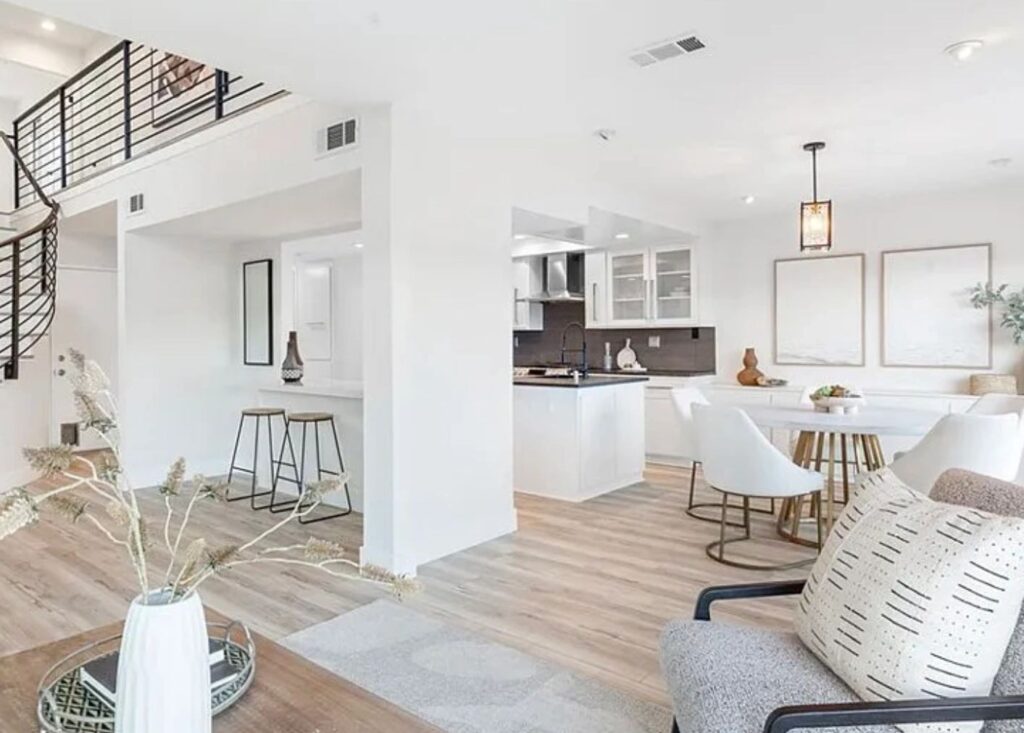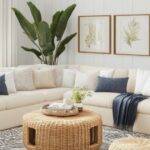Have you ever walked into a room and felt an immediate sense of calm and belonging? That feeling isn’t an accident—it’s the result of thoughtful interior design.
As a San Diego interior designer, I believe that a well-designed space does more than look good; it enhances your life.
You don’t need a complete overhaul to make a significant impact. By understanding a few core interior design principles, you can elevate your own space and create a home that truly reflects you.
These foundational concepts are the tools designers use to turn an ordinary room into a sanctuary.
From creating visual harmony to making a space feel inviting, these principles guide every decision. Let’s explore how you can apply them to transform your home.
Balance: The Foundation of Good Design
Balance is all about distributing visual weight in a room to create a sense of equilibrium. An unbalanced room can feel chaotic or unsettling. There are three main types of balance you can use.
Symmetrical Balance
Symmetrical balance is the easiest to understand. Think of a formal living room where two identical sofas face each other, separated by a coffee table.
It’s like drawing a line down the center of the room and having each side be a mirror image. This approach creates a feeling of stability, order, and formality.
You can achieve it by using matching nightstands, identical lamps on either side of a console, or paired armchairs.
Asymmetrical Balance
Asymmetrical balance is more complex but often creates a more dynamic and interesting space. Instead of mirroring objects, this technique uses different elements with similar visual weight to create equilibrium.
For example, you might balance a large sofa on one side of a room with two armchairs and a small table on the other.
Although the objects are different, their visual mass is comparable. This method feels more casual, modern, and less rigid than symmetry.
Radial Balance
Radial balance involves arranging elements around a central point. Think of a dining room with chairs arranged around a circular table or a seating area centered on a round coffee table.
This type of balance draws the eye inward and is great for creating a focal point and encouraging conversation.
Color Harmony: Setting the Mood
Color is one of the most powerful tools in interior design. It can influence your mood, make a room feel larger or smaller, and tie the entire space together. Creating a cohesive color palette is key to achieving harmony.
A great starting point is the 60-30-10 rule. This guideline helps you balance your colors effectively:
- 60% Dominant Color: This is your main color, typically used for walls, large rugs, or major furniture pieces like a sofa. It sets the overall tone of the room.
- 30% Secondary Color: This color supports the dominant hue and adds visual interest. Use it for accent chairs, drapery, or a feature wall.
- 10% Accent Color: This is your pop of color! It adds personality and appears in smaller items like throw pillows, artwork, and decorative accessories.
When choosing colors, consider the feeling you want to evoke. Blues and greens often create a serene, calming atmosphere, which is perfect for bedrooms and bathrooms.
In San Diego, we often draw inspiration from the coast, using sandy neutrals, soft blues, and seafoam greens. Warmer tones like reds, oranges, and yellows can make a space feel energetic and inviting, ideal for kitchens and dining areas.
Focal Point: Giving the Eye a Place to Land
Every room needs a focal point—a star feature that immediately draws your attention and anchors the space. Without one, a room can feel cluttered and directionless.
The focal point should be the first thing you notice when you enter.
Some rooms have built-in focal points, like a fireplace, a large picture window with a beautiful view, or unique architectural details. If your room doesn’t have one, you can create it. Here are a few ideas:
- A Bold Piece of Art: A large-scale painting or a gallery wall can serve as a powerful focal point.
- A Feature Wall: Paint one wall a dramatic color, apply striking wallpaper, or add textured paneling.
- Statement Furniture: An eye-catching sofa in a vibrant color, a unique canopy bed, or a sculptural coffee table can anchor your design.
Once you’ve established your focal point, arrange the other furniture and decor around it. This creates a natural flow and guides the eye through the space, making it feel cohesive and intentional.
Layering: Adding Depth and Personality
Layering is the secret to creating a space that feels rich, cozy, and thoughtfully curated. It involves combining different textures, materials, patterns, and lighting to add depth and visual interest.
A room without layers can feel flat and one-dimensional.
Layering Textures
Think about how different materials feel to the touch. Mix smooth and rough, soft and hard. For example, you could pair a sleek leather sofa with a chunky knit throw, velvet pillows, and a jute rug.
Add in wood, metal, and stone elements through furniture and decor. These textural contrasts make a space more engaging and inviting.
Layering Lighting
Good lighting design involves more than just a single overhead fixture. A well-lit room includes layers of light to accommodate different activities and moods.
- Ambient Lighting: This is the general, overall illumination of the room, often from a ceiling fixture or recessed lights.
- Task Lighting: This is focused light for specific activities, like a reading lamp by a chair or under-cabinet lighting in the kitchen.
- Accent Lighting: This type of lighting highlights features like artwork, architectural details, or plants.
By combining these three layers, you create a flexible and atmospheric environment that can be adjusted for any occasion.
Layering Decor
Finally, layer your decorative items to tell a story and show off your personality. Mix old and new pieces, display collections, and incorporate personal items like photos and travel souvenirs. This is where your home truly becomes your own.
Elevate Your Home with Professional Guidance
Understanding these interior design principles gives you the power to make meaningful changes in your home.
By thoughtfully applying balance, color, focal points, and layering, you can create a space that is not only beautiful but also deeply personal and functional.
If you’re feeling inspired but want a guiding hand, I’m here to help. As a San Diego interior designer, I specialize in creating spaces that are both stunning and livable.


